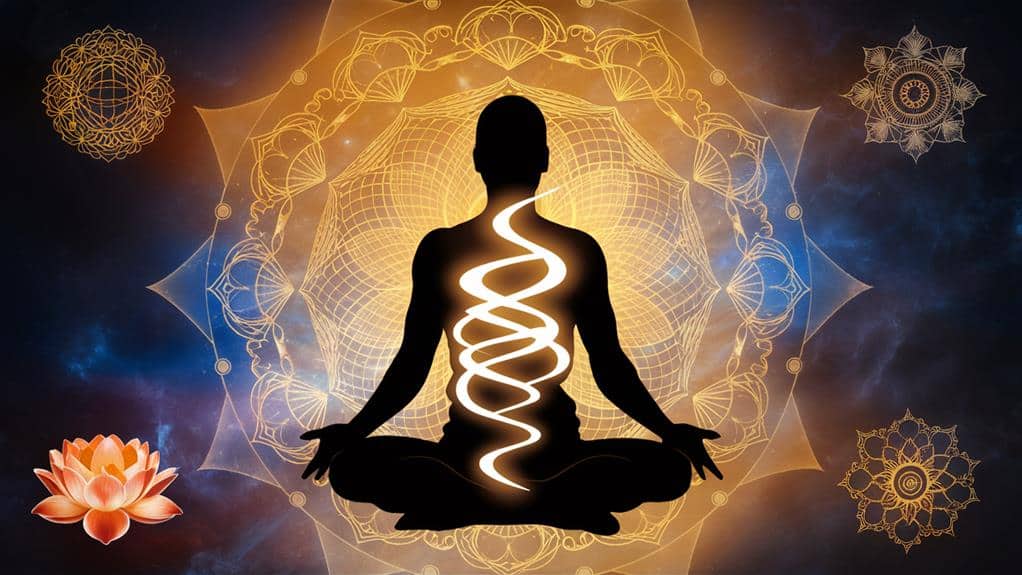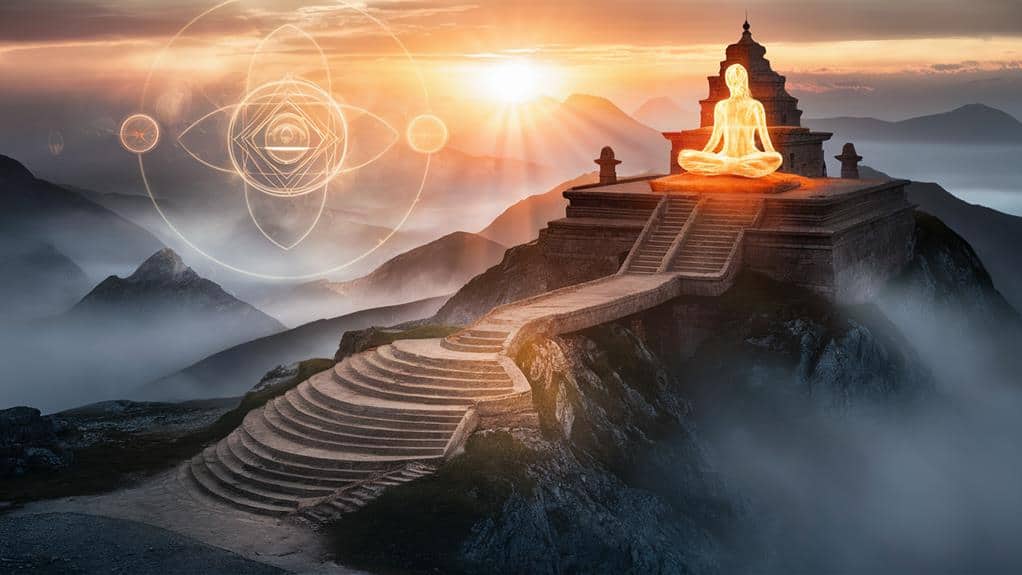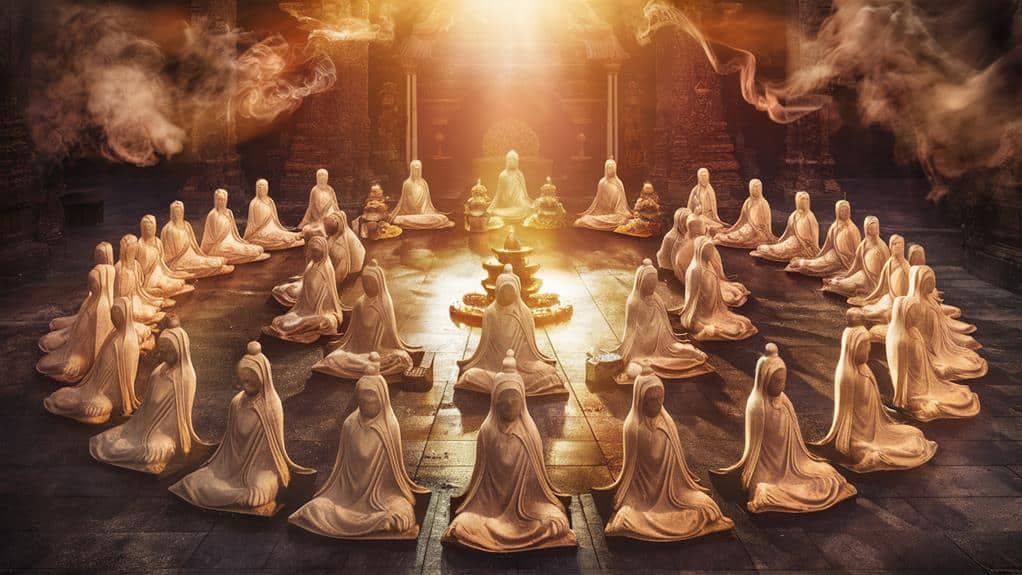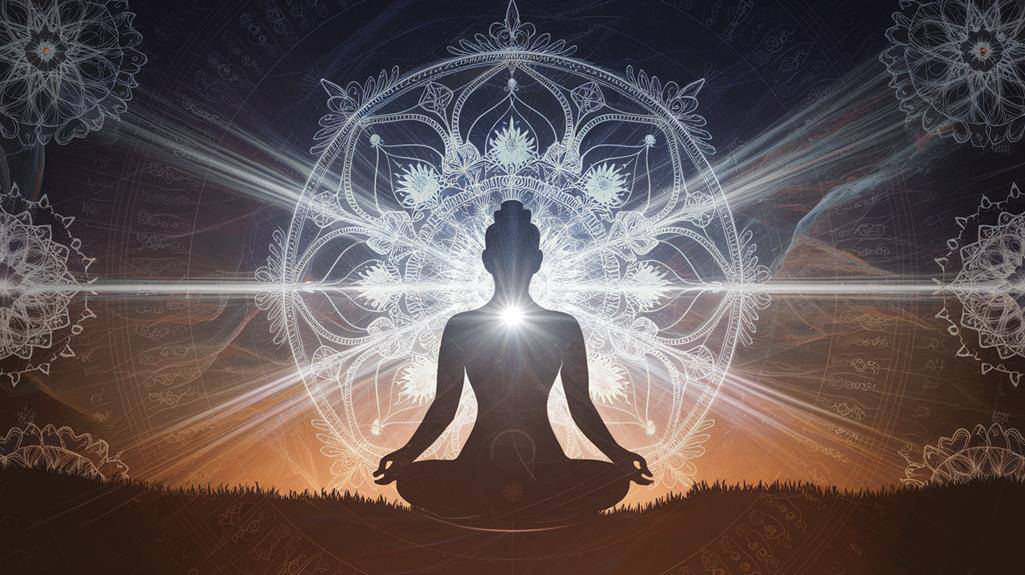The Concept of Spiritual Enlightenment Across Different Mystical Traditions
You’ve likely encountered the term “enlightenment” across various spiritual contexts, from Buddhist monasteries to Sufi mystics and Hindu yogis. While these traditions may differ in their methods and terminology, they’re all pointing to a remarkably similar destination: a profound shift in consciousness that transcends ordinary human experience. It’s a state that mystics describe as both deeply personal yet paradoxically universal, where individual identity dissolves into something far more expansive. As you consider this ancient pursuit that’s captivated seekers for millennia, you’ll discover how these diverse paths converge to illuminate the same timeless truth.
The Universal Call to Awakening

While mystical traditions may differ in their specific practices and terminology, they all point to a fundamental human yearning for spiritual awakening. You’ll find this universal call echoing through the sacred texts of every culture, whispering that there’s something more beyond your ordinary perception of reality.
It’s as if consciousness itself is gently nudging you toward a greater understanding of your true nature.
Whether you’re drawn to Buddhist meditation, Sufi whirling, or Christian contemplative prayer, you’re responding to the same timeless invitation to transcend the limitations of your conditioned existence.
This call to awakening isn’t just a religious concept – it’s woven into the very fabric of your being, manifesting as an inexplicable longing that material success alone can’t satisfy.
You might recognize it in moments of profound silence, in the questions that arise during sleepless nights, or in the mysterious sense that your current understanding of reality is somehow incomplete.
Each tradition offers you unique pathways to explore this fundamental human experience, but they’re all addressing the same core truth: you’re meant to awaken to a deeper dimension of existence.
Core Tenets Across Major Traditions
Mystic pathways across spiritual traditions reveal striking similarities in their fundamental teachings, despite their diverse cultural expressions and practices.
You’ll find that beneath the surface differences, mystical traditions consistently point to the transcendence of ego, the illusion of separateness, and the reality of an underlying unity that connects all existence.
Whether you’re exploring Buddhism’s concept of emptiness, Sufism’s divine love, or the Christian mystic’s union with God, you’ll encounter the recurring theme that your true nature extends far beyond your limited personal identity.
These traditions teach that you’re not bound by your thoughts, emotions, or bodily sensations – rather, you’re the boundless awareness in which all experience unfolds.
The paths may differ, but they all guide you toward recognizing that suffering stems from identification with the limited self, while liberation comes through realizing your essential nature.
You’ll discover that each tradition emphasizes direct experience over intellectual understanding, encouraging you to look within through meditation, contemplation, or devotional practices.
They unanimously suggest that truth isn’t found in concepts but in the immediate recognition of your fundamental nature.
Ancient Paths to Enlightenment

Through the corridors of time, ancient spiritual paths have offered seekers systematic approaches to enlightenment. You’ll find these timeless methods woven into the fabric of traditions spanning from the meditative practices of Himalayan yogis to the contemplative disciplines of desert mystics. Each path, though distinct in its approach, guides you toward the dissolution of ego and the recognition of ultimate reality.
You’re inheriting wisdom that’s been refined across millennia, whether you’re drawn to the rigorous self-inquiry of Advaita Vedanta, the mindfulness practices of Buddhist traditions, or the heart-centered devotion of Sufi mysticism.
These ancient paths don’t just offer theoretical frameworks; they provide practical tools you can apply in your spiritual journey. The methods include breath work (pranayama), sacred chanting, contemplative prayer, and various forms of meditation.
What’s remarkable is how these diverse paths often lead to similar revelations: the interconnectedness of all beings, the illusory nature of the separate self, and the presence of an underlying unity.
You’re walking trails blazed by countless seekers who’ve discovered that enlightenment isn’t just a distant ideal but a living possibility.
Signs of Spiritual Transformation
Along the path of spiritual awakening, distinct signs emerge that signal your inner transformation.
You’ll notice a profound shift in how you perceive daily experiences, finding deeper meaning in moments you once dismissed as ordinary. Your attachments to material possessions and superficial relationships begin to loosen, replaced by an authentic connection to life’s essential truths.
As you progress, you’ll discover a growing sense of inner peace that doesn’t depend on external circumstances.
Time seems to flow differently – you’re more present, less consumed by past regrets or future anxieties. Your intuition sharpens, and you’ll often sense truth beyond logical reasoning, accessing wisdom that transcends intellectual understanding.
You’ll find yourself naturally drawn to silence and contemplation, while your relationships transform into more conscious connections.
The boundaries between you and others begin to dissolve as you recognize the underlying unity of all existence. Your actions flow from a place of compassion rather than ego, and you’ll notice synchronicities appearing more frequently in your life, confirming your alignment with a deeper cosmic order.
Teachers and Their Methods

Great spiritual teachers break down complex wisdom into digestible insights, each employing unique methods to guide their students toward enlightenment. You’ll find that some masters emphasize silent meditation, while others engage in direct dialogue, challenging their students’ preconceptions through pointed questions and paradoxical statements.
These approaches, though different in form, serve as bridges between your current understanding and deeper spiritual truths.
In your journey, you’ll encounter teachers who employ traditional methods passed down through ancient lineages, preserving time-tested practices like visualization, mantra recitation, or physical disciplines.
Others have developed contemporary approaches that blend ancient wisdom with modern psychological insights. What’s essential isn’t the specific method but rather the teacher’s ability to meet you where you are, offering guidance that resonates with your current level of awareness.
The most effective teachers don’t create dependency but instead empower you to discover your own inner wisdom. They’re mirrors reflecting your true nature, skilled navigators who’ve mapped the territory of consciousness and can point you toward your own direct experience of truth.
Common Mystical Experiences
Mystical experiences share remarkable similarities across different spiritual traditions and cultures. You’ll find that seekers often report a profound sense of unity with all existence, where the boundaries between self and universe dissolve into an oceanic consciousness. This transcendent state transcends ordinary perception, revealing what mystics describe as the fundamental interconnectedness of all things.
When you explore these experiences deeply, you’ll discover common threads: the sensation of timelessness, where past and future merge into an eternal now; the ineffable quality of divine love that surpasses human understanding; and a direct knowledge that feels more real than everyday awareness.
You might encounter what mystics call “the void” – a paradoxical emptiness teeming with infinite potential – or experience sudden insights that illuminate the nature of reality.
These experiences often trigger profound transformations in your understanding of existence. You’ll find yourself discovering an inner silence that speaks volumes, a light that illuminates from within, and a deep knowing that transcends intellectual comprehension.
The mystic’s journey reveals that beneath our apparent differences lies a universal language of spiritual awakening.
Enlightenment in Modern Life

While ancient mystical experiences remain timeless, today’s seekers face unique challenges in pursuing enlightenment amid modern distractions. You’ll find yourself maneuvering through endless notifications, social media updates, and the constant buzz of technology that can pull you away from deeper awareness.
Yet within this digital chaos lies an opportunity to practice presence with unprecedented intensity. You don’t need to retreat to a mountaintop to find enlightenment in the modern world. Instead, you can transform your daily commute into a moving meditation, your workspace into a sanctuary of mindful attention, and your relationships into laboratories of compassionate awareness.
The key lies in bringing ancient wisdom into your contemporary reality, allowing the timeless teachings to illuminate your path through modern challenges. You’ll discover that enlightenment hasn’t changed – only the context has shifted.
Your smartphone can become a reminder to breathe consciously, your busy schedule an invitation to practice presence, and your urban environment a teacher of impermanence. By embracing these modern elements rather than fighting them, you’re creating a new paradigm of spiritual awakening that honors both ancient wisdom and contemporary life.
Beyond Religious Boundaries
Through centuries of spiritual exploration, enlightenment has transcended individual religious doctrines, revealing universal truths that bridge diverse faith traditions. You’ll find these common threads woven into the fabric of human consciousness, whether you’re studying Zen Buddhism’s concept of satori, Sufism’s fana, or the Christian mystic’s divine union.
Beyond the confines of organized religion, these shared experiences point to a deeper reality that you can access regardless of your spiritual background.
When you look closely at mystical traditions worldwide, you’ll discover striking parallels in their descriptions of enlightened states: a dissolution of ego boundaries, a sense of oneness with the universe, and a profound inner peace that defies ordinary explanation.
These similarities aren’t mere coincidence – they’re signposts pointing toward fundamental truths about consciousness and human potential. You’ll notice that authentic spiritual awakening often leads practitioners beyond their initial religious frameworks, opening doors to universal wisdom that transcends cultural and doctrinal differences.
This convergence suggests that enlightenment isn’t confined to any single path but represents a universal potential within human consciousness, accessible through various contemplative practices and traditions.









